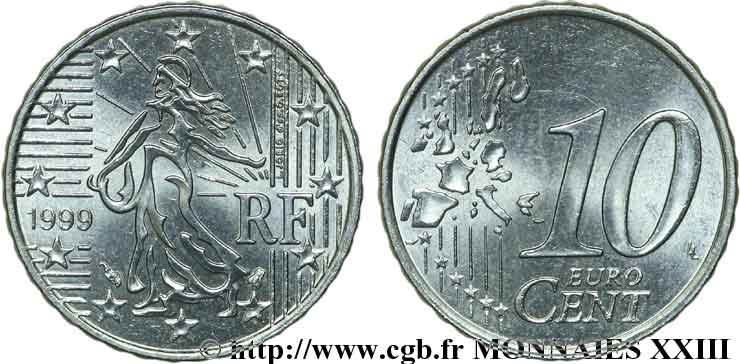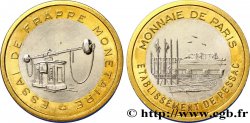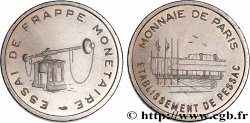- Accueil
- > Архивы
- > Монеты евро
v23_2116 - EUROPEAN CENTRAL BANK 10 centimes d’euro, frappe sur flan blanc 1999 Pessac
MONNAIES 23 (2004)
Начальная цена : 1 000.00 €
Назначить цену : 2 500.00 €
Цена реализации : 1 260.00 €
Количество ставок : 2
Максимальная предлагаемая цена : 1 264.00 €
Начальная цена : 1 000.00 €
Назначить цену : 2 500.00 €
Цена реализации : 1 260.00 €
Количество ставок : 2
Максимальная предлагаемая цена : 1 264.00 €
Тип 10 centimes d’euro, frappe sur flan blanc
Дата: 1999
Монетный двор / Город: Pessac
Металл: white metal
Диаметр: 19,5 mm
Ориентация осей монеты: 12 h.
Вес: 4,10 g.
Век: cannelée
Редкость: UNIQUE
Комментарии о состоянии
Exemplaire splendide avec d’infimes marques de manipulation et de doigts dans les champs
Ссылки в каталоге: :
Лицевая сторона
Аверс: описание: La France sous les traits d’une Semeuse marchant à gauche et semant à contre-vent ; derrière le soleil levant ; traits horizontaux à gauche et verticaux à droite avec signature L. JORIO d’ap. O. ROTY.
Обратная сторона
Реверс: легенда: 10/ EURO/ CENT.
Реверс: Описание: Carte de l’Union européenne sur six traits tirés entre deux groupes de six étoiles formant les douze pays de la zone euro, signature en monogramme LL.
Комментарий
Étonnant exemplaire en alliage blanc. Cette 10 centimes n’est pas en acier comme supposé dans EURO 2, page 93 et ne réagit pas à l’aimant. Ce qui est surprenant, par contre, est le poids de cet exemplaire qui est parfaitement juste ! Nous ne nous expliquons pas clairement d’où vient ce flan. S’agit-il d’un flan destiné à une fabrication étrangère, au module et poids identiques aux 10 centimes d’euro ? Ne s’agit-il pas plutôt d’un flan provenant d’un alliage insuffisamment dosé en cuivre (théoriquement 89 %) et sur-dosé en aluminium (théoriquement 5 %), en zinc (théoriquement 5 %) et/ou en étain (théoriquement 1 %) ? Seule une analyse métallique non-destructive permettrait peut-être de répondre à cette seconde question. Il s’agit en tous cas d’un exemplaire parfaitement authentique, issu de l’atelier de Pessac et d’un grand intérêt.
Amazing example in white alloy. This 10 cent coin is not made of steel as assumed in EURO 2, page 93 and does not react to the magnet. What is surprising, however, is the weight of this coin, which is perfectly accurate! We do not clearly understand where this flan comes from. Is it a flan intended for foreign manufacture, with the same modulus and weight as the 10 euro cents? Is it not rather a flan from an alloy with an insufficient copper content (theoretically 89%) and an over-concentration of aluminum (theoretically 5%), zinc (theoretically 5%) and/or tin (theoretically 1%)? Only a non-destructive metallic analysis would perhaps allow us to answer this second question. In any case, it is a perfectly authentic example, from the Pessac workshop and of great interest.
Amazing example in white alloy. This 10 cent coin is not made of steel as assumed in EURO 2, page 93 and does not react to the magnet. What is surprising, however, is the weight of this coin, which is perfectly accurate! We do not clearly understand where this flan comes from. Is it a flan intended for foreign manufacture, with the same modulus and weight as the 10 euro cents? Is it not rather a flan from an alloy with an insufficient copper content (theoretically 89%) and an over-concentration of aluminum (theoretically 5%), zinc (theoretically 5%) and/or tin (theoretically 1%)? Only a non-destructive metallic analysis would perhaps allow us to answer this second question. In any case, it is a perfectly authentic example, from the Pessac workshop and of great interest.








 Cообщить об ошибке
Cообщить об ошибке Распечатать страницу
Распечатать страницу Отправить мой выбор
Отправить мой выбор Задать вопрос
Задать вопрос Consign / sell
Consign / sell
 Информация
Информация










